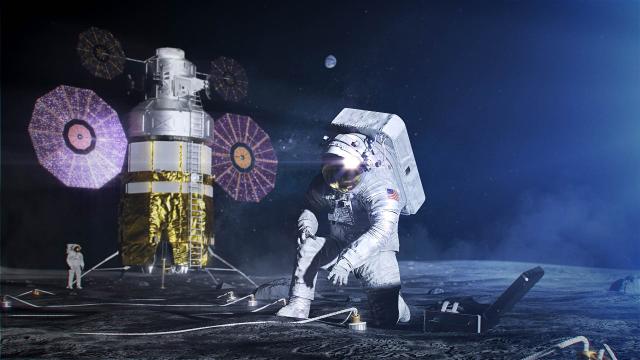For the pending Artemis missions to the Moon, NASA has already selected the southern polar region as the destination for its astronauts, but an exact landing spot has yet to be determined. Given the needs of the Artemis program, this won’t be easy.
Artemis presents a unique challenge for NASA and its astronauts, who are scheduled to visit the lunar surface at some point this decade, possibly as early as 2024. Unlike the Apollo missions, which landed within the Moon’s mid-latitudes, the Artemis excursions will take place near the lunar south pole.
There, the astronauts will be exposed to dramatic shifts in light and temperature. Sounds like an awful place to conduct a mission, but the polar regions are believed to hold a rather precious resource: frozen water. And indeed, the detection and retrieval of water ice from the lunar surface is a key scientific goal of the Artemis project.
Mission planners at NASA are currently mulling over the needs of the mission and evaluating possible landing spots and locations for the basecamp. As NASA explains in a recent press release, the chosen destination should provide ample access to sunlight, which will be used to power the basecamp, as well as easy access to spots rich in water ice. Ideally, the location should also feature moderate temperature swings, to make things easier on the equipment.
Thankfully, the rugged topography of the Moon should provide such a location. NASA thinks it might be possible to land along the edge of an impact crater, which would also provide access to the perpetually dark areas inside. Indeed, given the low angle of incoming sunlight at the poles, the interior portions of deep craters never get touched by sun. It’s within these dark pockets that scientists expect frozen water to reside.
A key difference between Earth and the Moon has to do with the tilt of each orb on its axis. Earth features a 23.5-degree tilt, which is why both the south and north pole “tip” toward the Sun depending on the season. By comparison, the Moon is very un-tilted, as it’s shifted by only 1.5 degrees on its axis.
So for astronauts standing at either lunar pole, the height of the Sun would largely remain the same over the course of a day. As NASA put it, if “a person were standing on a hilltop near the lunar South Pole during daylight hours, at any time of year, they would see the Sun moving across the horizon, skimming the surface like a flashlight laying on a table.”
W. Brent Garry, a geologist at NASA’s Goddard Space Flight Centre in Greenbelt, Maryland, along with his colleagues, created a virtual reality tour of a hypothetical mission at the lunar south pole as part of an effort to acclimatize mission planners and astronauts to the environment. A newly released NASA video of the simulation (above) shows how strange it’s going to be for astronauts working near the southern pole.
As noted, the astronauts, in addition to ample light, will require access to dark craters. The discovery of water ice is important from a scientific point of view but also from a practical perspective, as water can be used to augment life support systems.
“One idea is to set up camp in an illuminated zone and traverse into these craters, which are exceptionally cold,” explained Daniel Moriarty, NASA Goddard planetary scientist, in the press release. “Temperatures in some of the coldest craters can dip to about -391 degrees Fahrenheit (-235 degrees Celsius).”
A concept that’s currently being considered would see the astronauts land on a relatively flat surface along a well-illuminated crater edge or ridge. The spot must be reasonably flat to prevent the lander from tipping over.
At the same time, however, the landing spot will need to be reasonably far away from the main area of activity. This has to do with the nature of the landing, as the spacecraft’s thrusters will kick up tremendous amounts of material in the form of dust and rocks, water, and gases. NASA estimates that the Artemis landing will redistribute hundreds of pounds of surface material and send it flying in the low gravity for miles. The craft’s thrusters will also contaminate the immediate landing area, which is why the base camp, which will include a habitat and solar panels, will be located at least a half-mile away from the landing site.
“You want to take advantage of the landforms, such as hills, that can act as barriers to minimise the impact of contamination,” said Ruthan Lewis, leader of NASA’s South Pole site analysis and planning team, in the statement. “So, we’re looking at distances, elevations, and slopes in our planning.”
Lastly, and perhaps most obviously, the Artemis landing spot needs to be on the Earth-facing side of the Moon to minimise communication disruptions with ground controllers. Interestingly, the south polar region will take astronauts very close to the outward facing side, and it’s very possible that they’ll find some rocks that originated at the “dark” side, tossed over by impact events. That would be a bonus, however, and a neat opportunity for scientists to study materials from the Moon’s opposite face.
With all this in mind, it’ll be interesting to learn about the landing site once it’s chosen by NASA. Whichever spot they choose, it’ll instantly become the most captivating spot on our natural satellite.
